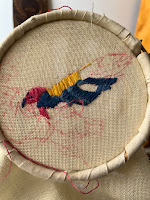
I have been working a sampler of Mexican embroidery motifs and stitches for my presentation to the World Embroidery Study Group in February. I began with a free sampler design from the Victoria and Albert Museum, presented as a small bag.
While the designs are good, I found the instructions less so. They suggested copying the design on to fabric. Since a number of motifs were cross-stitch, and we know much Mexican cross-stitch is counted, this didn't make much sense to me. While the downloadable pdf has grid marks, the hand-drawn cross-stitches don't conform to the grid.
I decided to choose some of the motifs and work them on even weave linen. To save my eyes I used 25 count. It took a bit of translation and adjustment, but I finished with three motifs and a border more or less in line with those on the V&A sampler.
I started with the border, then added the deer, and fitted the others around this.
 Before working the lower border, I decided to work the back of the bag with an Otomi design, taken from a book of such.
Before working the lower border, I decided to work the back of the bag with an Otomi design, taken from a book of such.  Otomi embroidery is distinctive, produced by artists in Tenango de Doria, Hildago, North East of Mexico City. It features bright colours, animals, birds and flowers, worked mainly in a one-sided satin stitch. It is a flourishing business.
Otomi embroidery is distinctive, produced by artists in Tenango de Doria, Hildago, North East of Mexico City. It features bright colours, animals, birds and flowers, worked mainly in a one-sided satin stitch. It is a flourishing business. Otomi artists hand draw designs on to fabric for the embroiderers to work.

The back of the embroidery is amazing, and the garment could probably be worn inside out!
My effort does not compare. To begin with, the style was not designed for even weave linen, especially not a loose even weave. While I could never have reproduced the fine product of the Otomi, the linen was very limiting, and would not have been used by an Otomi artisan (or an embroiderer with any sense!).
 As a sample it provides a bit to talk about. I would probably have done better to work on cotton and appliqué it on, but it serves a purpose.
As a sample it provides a bit to talk about. I would probably have done better to work on cotton and appliqué it on, but it serves a purpose. The back of mine could definitely NOT be used - but it does show the technique.
While I had worked the top border line by line, I worked the lower border by following the colour lines through. This is a more thread-efficient way to work, but has a greater chance of a counting error. I also ran out of three colours - I had forgotten how thread-hungry cross stitch can be when worked in dense geometric patterns.
Fortunately, two of the colours were in a bundle of surplus threads a friend had given me, and I substituted for the third.
 I thought a fabric I recently bought from Batik Fabrics Online would go nicely as lining and yesterday I made the bag, using a narrow strip of the lining as a strap to carry it.
I thought a fabric I recently bought from Batik Fabrics Online would go nicely as lining and yesterday I made the bag, using a narrow strip of the lining as a strap to carry it.It will make a half-decent project bag. and will be of interest to the World Embroidery Study Group
It has certainly given me the beginnings of an understanding of the culture and diversity of Mexico, and great respect for the work of Mexican embroiderers, especially the Otomi.








































